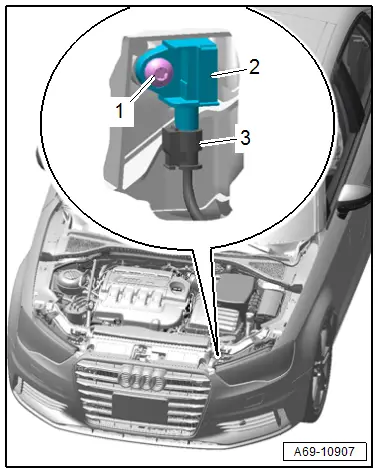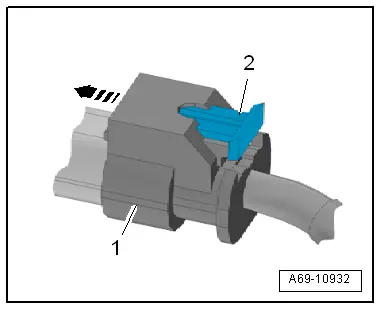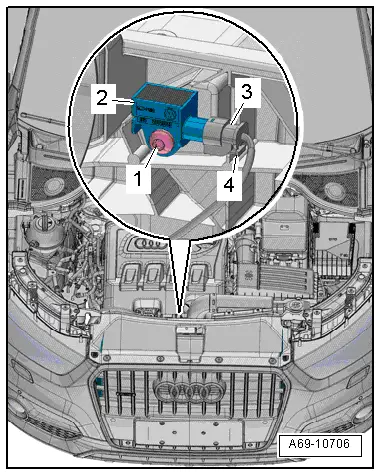Audi Q3: Driver Front Airbag Crash Sensor -G283-, Removing and Installing
Drive/Front Passenger Front Airbag Crash Sensor -G283-/-G284-, Removing and Installing, USA and Canada Market-Specific
Removing
 WARNING
WARNING
Follow all safety precautions when working with pyrotechnic components. Refer to → Chapter "Pyrotechnic Components Safety Precautions".
- Disconnect the battery ground cable with the ignition turned on. Refer to → Electrical Equipment; Rep. Gr.27; Battery; Battery, Disconnecting and Connecting.
- Open the hood.
- Driver Front Airbag Crash Sensor -G283-: Remove the washer fluid reservoir filler tube. Refer to → Electrical Equipment; Rep. Gr.92; Windshield Washer System; Washer Fluid Reservoir, Removing and Installing.
- Remove the screw -1- and the front airbag crash sensor -2- from the lock carrier.
 WARNING
WARNING
Before handling pyrotechnic components (for example, disconnecting the connector), the person handling it must "discharge static electricity". This can be done by touching the door striker, for example.
- Disconnect the connector -3-.

- To do this pull out the connector lock -2- and push down -arrow-, disconnect the connector -1- on the crash sensor.

Installing
 WARNING
WARNING
- Follow all safety precautions when working with pyrotechnic components. Refer to → Chapter "Pyrotechnic Components Safety Precautions".
- Before handling pyrotechnic components (for example, connecting the connector), the person handling it must "discharge static electricity". This can be done by touching the door striker, for example.
- Connect the connector -1- to the crash sensor until it clicks into place -arrow-.
- Push the connector lock -2- to secure the connector.
Installation is performed in reverse order of removal, while noting the following:
 Note
Note
- Make sure the connectors are installed correctly and are secure.
- Make sure the wires do not get caught.
 WARNING
WARNING
Ignition must be on when connecting battery. If pyrotechnic components (for example, airbag, belt tensioner) are not repaired correctly, they may deploy unintentionally after connecting battery. There must not be anyone inside the vehicle when connecting the battery.
- Connect the battery ground cable with the ignition turned on. Refer to → Electrical Equipment; Rep. Gr.27; Battery; Battery, Disconnecting and Connecting.
 Note
Note
If the Airbag Indicator Lamp -K75- indicates a fault, check the DTC memory, erase it and check it again using the Vehicle Diagnostic Tester → Vehicle diagnostic tester.
Installation notes, for example tightening specifications, replacing components. Refer to → Chapter "Component Location Overview - Airbag Crash Sensors, USA and Canada Market-Specific".

Driver Front Airbag Crash Sensor -G283-, Removing and Installing, Not USA and Canada Market-Specific
NOT FOR NORTH AMERICAN MARKET
Removing
 WARNING
WARNING
Follow all safety precautions when working with pyrotechnic components. Refer to → Chapter "Pyrotechnic Components Safety Precautions".
There is a risk of injury if the engine starts automatically in vehicles with the Start/Stop System.
- For vehicles with an activated Start/Stop System (recognizable from a notification in the instrument cluster), the motor can be started automatically if needed.
- Make sure that the start/stop system is deactivated when working on the vehicle (turn off the ignition, turn on the ignition when necessary).
- Disconnect the battery ground cable with the ignition turned on. Refer to → Electrical Equipment; Rep. Gr.27; Battery; Battery, Disconnecting and Connecting.
- Open the hood.
- Remove the air guide between the lock carrier and the air filter housing. Refer to → Rep. Gr.23; Air Filter; Overview - Air Filter Housing or → Rep. Gr.24; Air Filter; Overview - Air Filter Housing.
 WARNING
WARNING
Before handling pyrotechnic components (for example, disconnecting the connector), the person handling it must "discharge static electricity". This can be done by touching the door striker, for example.
- Pull out connector lock -4- and press down, disconnect harness connector -3- at the crash sensor.
- Remove bolt -1- and front airbag crash sensor -2-.
Installing
 WARNING
WARNING
- Follow all safety precautions when working with pyrotechnic components. Refer to → Chapter "Pyrotechnic Components Safety Precautions".
- Before handling pyrotechnic components (for example, connecting the connector), the person handling it must "discharge static electricity". This can be done by touching the door striker, for example.
Install in reverse order of removal. Note the following:
 Note
Note
- Make sure the connectors are installed correctly and are secure.
- Make sure the wires do not get caught.
 WARNING
WARNING
Ignition must be on when connecting battery. If pyrotechnic components (for example, airbag, belt tensioner) are not repaired correctly, they may deploy unintentionally after connecting battery. There must not be anyone inside the vehicle when connecting the battery.
- Connect the battery ground cable with the ignition turned on. Refer to → Electrical Equipment; Rep. Gr.27; Battery; Battery, Disconnecting and Connecting.
 Note
Note
If the Airbag Indicator Lamp -K75- indicates a fault, check the DTC memory, erase it and check it again using the Vehicle Diagnostic Tester → Vehicle diagnostic tester.
Installation notes, for example tightening specifications, replacing components. Refer to → Chapter "Component Location Overview - Airbag Crash Sensors".


